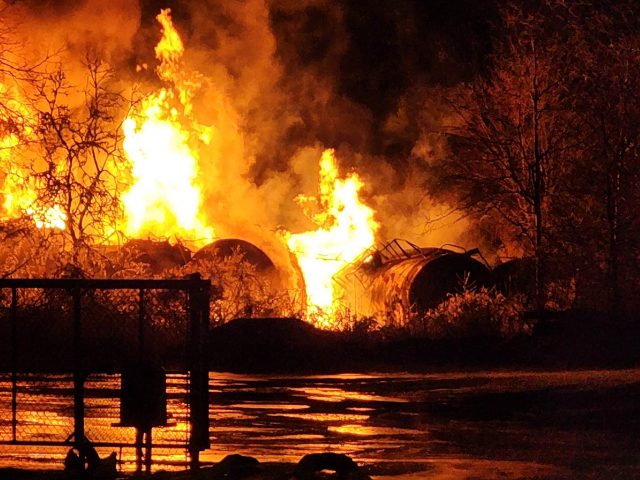
East Palestine, Ohio (June 25, 2024) – The National Transportation Safety Board (NTSB) has concluded its investigation into the Norfolk Southern Railway train derailment, which resulted in a hazardous material release and subsequent fires.
Incident Overview
On the night of February 3, 2023, at approximately 8:54 p.m., Norfolk Southern Railway (NS) train 32N, traveling eastbound, derailed at milepost 49.5 on the NS Fort Wayne Line of the Keystone Division in East Palestine, Ohio. The derailment involved 38 mixed freight railcars, three of which were tank cars carrying flammable and combustible hazardous materials. These cars were mechanically breached, igniting a fire that spread to other derailed tank cars containing both hazardous and non-hazardous materials, as well as additional freight cars.
Emergency responders quickly established a one-mile evacuation zone, impacting about 2,000 residents. Among the derailed equipment were five hazardous materials tank cars carrying vinyl chloride monomer (VCM), a highly flammable compressed liquefied gas. Although these VCM tank cars were not initially breached during the derailment, four of them were exposed to the fire, causing material to release from their pressure relief devices until the afternoon of February 4.
Sciotopost cameras were on the scene during the derailment and burn off of debris
Based on information from NS and its contractors about a potential dangerous chemical reaction within a VCM tank car, the incident commander expanded the evacuation zone and decided to perform a “vent and burn” procedure on all five VCM tank cars on February 6. This decision was made despite dissenting opinions from the VCM shipper, which NS and its contractors did not communicate to the incident commander. At 4:37 p.m., a contractor breached the VCM tank cars, releasing and igniting their contents. Remarkably, no injuries were reported during the derailment or emergency response.
Findings
The NTSB determined the probable cause of the derailment was the failure of the L1 bearing on the 23rd railcar, which overheated and caused the axle to separate, leading to the derailment. The post-derailment fire was likely initiated by the release of a Class 3 flammable liquid from a punctured DOT-111 tank car. The severity of the hazardous materials release was exacerbated by the continued use of DOT-111 tank cars for hazardous materials transport, the failure of NS and its contractors to communicate critical expertise and dissenting opinions to the incident commander, and the misrepresentation by NS and its contractors of the tank cars being at risk of catastrophic failure from a polymerization reaction. This misinformation created undue urgency, resulting in the unnecessary venting and burning of the VCM tank cars.
Additionally, the exposure of emergency responders and the public to post-derailment hazards was worsened by NS’s delay in providing train consist information and Ohio’s insufficient training requirements for volunteer firefighters.
Recommendations
Following its investigation, the NTSB issued 31 new recommendations and reiterated one previously issued recommendation. The Board also classified four previously issued recommendations.
Next Steps
The NTSB will make final revisions to its report and distribute pertinent safety recommendation letters to relevant recipients as soon as possible.











